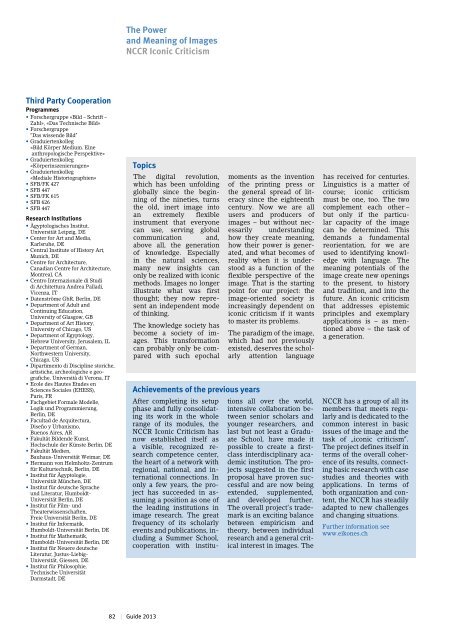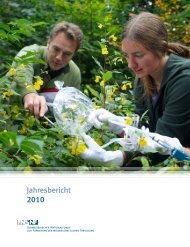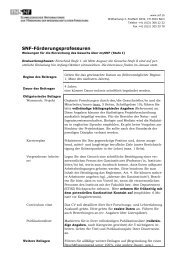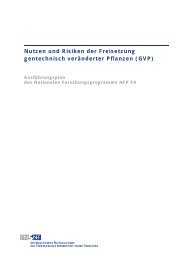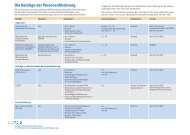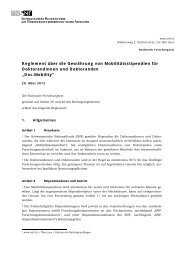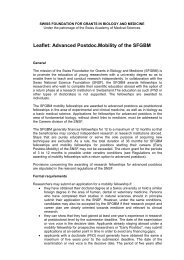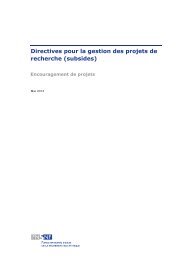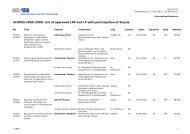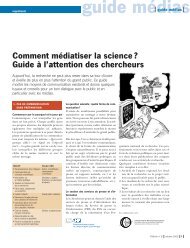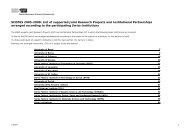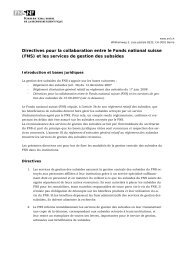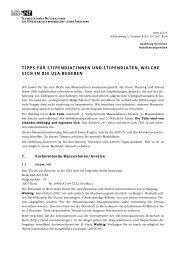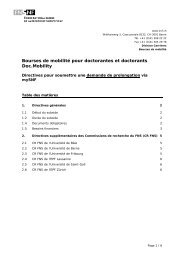NCCR Guide 2013 - Schweizerischer Nationalfonds (SNF)
NCCR Guide 2013 - Schweizerischer Nationalfonds (SNF)
NCCR Guide 2013 - Schweizerischer Nationalfonds (SNF)
You also want an ePaper? Increase the reach of your titles
YUMPU automatically turns print PDFs into web optimized ePapers that Google loves.
The Power<br />
and Meaning of Images<br />
<strong>NCCR</strong> Iconic Criticism<br />
Third Party Cooperation<br />
Programmes<br />
• Forschergruppe «Bild – Schrift –<br />
Zahl», «Das Technische Bild»<br />
• Forschergruppe<br />
“Das wissende Bild”<br />
• Graduiertenkolleg<br />
«Bild Körper Medium. Eine<br />
anthropologische Perspektive»<br />
• Graduiertenkolleg<br />
«Körperinszenierungen»<br />
• Graduiertenkolleg<br />
«Mediale Historiographien»<br />
• SFB/FK 427<br />
• SFB 447<br />
• SFB/FK 615<br />
• SFB 626<br />
• SFB 447<br />
Research Institutions<br />
• Ägyptologisches Institut,<br />
Universität Leipzig, DE<br />
• Center for Art and Media,<br />
Karlsruhe, DE<br />
• Central Institute of History Art,<br />
Munich, DE<br />
• Centre for Architecture,<br />
Canadian Centre for Architecture,<br />
Montreal, CA<br />
• Centro Internazionale di Studi<br />
di Architettura Andrea Palladi,<br />
Vicenza, IT<br />
• Datenströme GbR, Berlin, DE<br />
• Department of Adult and<br />
Continuing Education,<br />
University of Glasgow, GB<br />
• Department of Art History,<br />
University of Chicago, US<br />
• Department of Egyptology,<br />
Hebrew University, Jerusalem, IL<br />
• Department of German,<br />
Northwestern University,<br />
Chicago, US<br />
• Dipartimento di Discipline storiche,<br />
artistiche, archeologiche e geografiche,<br />
Università di Verona, IT<br />
• Ecole des Hautes Etudes en<br />
Sciences Sociales (EHESS),<br />
Paris, FR<br />
• Fachgebiet Formale Modelle,<br />
Logik und Programmierung,<br />
Berlin, DE<br />
• Facultad de Arquitectura,<br />
Diseño y Urbanismo,<br />
Buenos Aires, AR<br />
• Fakultät Bildende Kunst,<br />
Hochschule der Künste Berlin, DE<br />
• Fakultät Medien,<br />
Bauhaus-Universität Weimar, DE<br />
• Hermann von Helmholtz-Zentrum<br />
für Kulturtechnik, Berlin, DE<br />
• Institut für Ägyptologie,<br />
Universität München, DE<br />
• Institut für deutsche Sprache<br />
und Literatur, Humboldt-<br />
Universität Berlin, DE<br />
• Institut für Film- und<br />
Theaterwissenschaften,<br />
Freie Universität Berlin, DE<br />
• Institut für Informatik,<br />
Humboldt-Universität Berlin, DE<br />
• Institut für Mathematik,<br />
Humboldt-Universität Berlin, DE<br />
• Institut für Neuere deutsche<br />
Literatur, Justus-Liebig-<br />
Universität, Giessen, DE<br />
• Institut für Philosophie,<br />
Technische Universität<br />
Darmstadt, DE<br />
Topics<br />
The digital revolution,<br />
which has been unfolding<br />
globally since the beginning<br />
of the nineties, turns<br />
the old, inert image into<br />
an extremely flexible<br />
instrument that everyone<br />
can use, serving global<br />
communication and,<br />
above all, the generation<br />
of knowledge. Especially<br />
in the natural sciences,<br />
many new insights can<br />
only be realized with iconic<br />
methods. Images no longer<br />
illustrate what was first<br />
thought; they now represent<br />
an independent mode<br />
of thinking.<br />
The knowledge society has<br />
become a society of images.<br />
This transformation<br />
can probably only be compared<br />
with such epochal<br />
Achievements of the previous years<br />
moments as the invention<br />
of the printing press or<br />
the general spread of literacy<br />
since the eighteenth<br />
century. Now we are all<br />
users and producers of<br />
images – but without necessarily<br />
understanding<br />
how they create meaning,<br />
how their power is generated,<br />
and what becomes of<br />
reality when it is understood<br />
as a function of the<br />
flexible perspective of the<br />
image. That is the starting<br />
point for our project: the<br />
image-oriented society is<br />
increasingly dependent on<br />
iconic criticism if it wants<br />
to master its problems.<br />
The paradigm of the image,<br />
which had not previously<br />
existed, deserves the scholarly<br />
attention language<br />
After completing its setup<br />
phase and fully consolidating<br />
its work in the whole<br />
range of its modules, the<br />
<strong>NCCR</strong> Iconic Criticism has<br />
now established itself as<br />
a visible, recognized research<br />
competence center,<br />
the heart of a network with<br />
regional, national, and international<br />
connections. In<br />
only a few years, the project<br />
has succeeded in assuming<br />
a position as one of<br />
the leading institutions in<br />
image research. The great<br />
frequency of its scholarly<br />
events and publications, including<br />
a Summer School,<br />
cooperation with institutions<br />
all over the world,<br />
intensive collaboration between<br />
senior scholars and<br />
younger researchers, and<br />
last but not least a Graduate<br />
School, have made it<br />
possible to create a firstclass<br />
interdisciplinary academic<br />
institution. The projects<br />
suggested in the first<br />
proposal have proven successful<br />
and are now being<br />
extended, supplemented,<br />
and developed further.<br />
The overall project‘s trademark<br />
is an exciting balance<br />
between empiricism and<br />
theory, between individual<br />
research and a general critical<br />
interest in images. The<br />
has received for centuries.<br />
Linguistics is a matter of<br />
course; iconic criticism<br />
must be one, too. The two<br />
complement each other –<br />
but only if the particular<br />
capacity of the image<br />
can be determined. This<br />
demands a fundamental<br />
reorientation, for we are<br />
used to identifying knowledge<br />
with language. The<br />
meaning potentials of the<br />
image create new openings<br />
to the present, to history<br />
and tradition, and into the<br />
future. An iconic criticism<br />
that addresses epistemic<br />
principles and exemplary<br />
applications is – as mentioned<br />
above – the task of<br />
a generation.<br />
<strong>NCCR</strong> has a group of all its<br />
members that meets regularly<br />
and is dedicated to the<br />
common interest in basic<br />
issues of the image and the<br />
task of „iconic criticism“.<br />
The project defines itself in<br />
terms of the overall coherence<br />
of its results, connecting<br />
basic research with case<br />
studies and theories with<br />
applications. In terms of<br />
both organization and content,<br />
the <strong>NCCR</strong> has steadily<br />
adapted to new challenges<br />
and changing situations.<br />
Further information see<br />
www.eikones.ch<br />
82 | <strong>Guide</strong> <strong>2013</strong>


